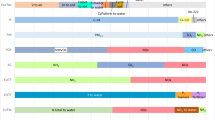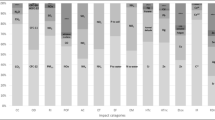Abstract
Purpose
The purpose of this study is to review the current landscape of the link between life cycle assessment and greenhouse gas accounting. This paper summarizes this link and the findings of a data source review conducted by an American Center for Life Cycle Assessment-Society of Environmental Toxicology and Chemistry working group.
Methods
In this paper, we review the working group’s current research on the use of LCA for indirect emissions reporting, including a literature review covering guidelines and standards, datasets, and databases applicable for North American GHG accounting using life cycle approaches. We document key attributes of each reviewed source. We also developed surveys for ACLCA-SETAC members to provide information on how each uses LCA-based techniques for GHG accounting.
Results
We summarize our findings including recommendations for using LCA data for indirect GHG emissions accounting, discussion of current data gaps and next steps to support streamlined and consistent reporting. We also provide an analysis of how LCA resources are used in different climate-based programs such as science-based targets. Lastly, we summarize the findings of survey results, such as the most common type of LCA data source used for GHG accounting and the GHG accounting categories where LCA is most applicable.
Conclusions
The study demonstrates the importance of using LCA for GHG accounting. The paper summarizes the outcomes of each objective identified by the working group and identifies the remaining data gaps and challenges when linking LCA and GHG accounting.



Similar content being viewed by others
Notes
The US Securities and Exchange Commission has proposed a rule that would require all publicly traded US companies to tell investors about their greenhouse gas emissions and how they manage risks related to climate change and future climate regulations.
Emission factors are results that are already characterized by global warming potential (e.g., kg CO2 eq. per kg material). Global warming potential is defined by the Intergovernmental Panel on Climate Change (IPCC) according to different time horizons.
Survey form available to view at: https://docs.google.com/forms/d/e/1FAIpQLScHiNw_FBQB5t1OdGwLQSNyoMDc29kVRirdrY13WuZC8-jiEw/viewform.
References
Argonne National Laboratory (2021) GREET Model. https://www.greet.es.anl.gov. Accessed 6 Jan 2022
Bhatia P, Cummis C, Draucker L et al (2011) Greenhouse gas protocol product life cycle accounting and reporting standard
Bilec M, Ries R, Matthews HS, Sharrard AL (2006) Example of a hybrid life-cycle assessment of construction processes. J Infrastruct Syst 12:207–215. https://doi.org/10.1061/(ASCE)1076-0342(2006)12:4(207)
BMW Group (2020) Sustainable Value Report 2019. München
C40 (2018) Consumption based GHG emissions of C40 cities
CDP (2022) Guidance for companies. https://www.cdp.net/en/guidance/guidance-for-companies#8b7fadc232e1bab9268512963662f431. Accessed 16 May 2022
CDP (2021) Companies score. https://www.cdp.net/en/companies/companies-scores. Accessed 25 May 2022
databahn (2021) Fortune 500 list. https://www.databahn.com/products/2021-fortune-500-list-free-excel-spreadsheet-list-download. Accessed 16 May 2022
DEFRA (2022) Greenhouse gas reporting: conversion factors 2021. https://www.gov.uk/government/publications/greenhouse-gas-reporting-conversion-factors-2021. Accessed 14 Aug 2022
ERG (2021) Estimating energy sector greenhouse gas emissions under New York State’s Climate Leadership and Community Protection Act. Eastern Research Group Inc, Lexington, USA
Erickson P, Allaway D, Lazarus M, Stanton EA (2012) A consumption-based GHG inventory for the U.S. State of Oregon. Environ Sci Technol 46:3679–3686. https://doi.org/10.1021/es203731e
European Commission (2018) Product environmental footprint category rules guidance—version 6.3
Federal LCA Commons (2022) In: 2014. https://www.lcacommons.gov. Accessed 6 Jan 2022
Fortune (2021) Fortune 500. https://www.fortune.com/fortune500/. Accessed 16 May 2022
Fortune Media IP Limited (2021) Fortune 500. https://www.fortune.com/fortune500/. Accessed 13 Aug 2022
GreenDelta (2021) openLCA – the Life Cycle and Sustainability Modeling Suite. https://www.openlca.org/openlca/. Accessed 6 Jan 2022
Greenhouse Gas Protocol (2011) Corporate Value Chain (Scope 3) Accounting and Reporting Standard: Supplement to the GHG Protocol Corporate Accounting and Reporting Standard. World Resources Institute and World Business Council for Sustainable Development. https://www.ghgprotocol.org/sites/default/files/standards/Corporate-Value-Chain-Accounting-Reporing-Standard_041613_2.pdf. Accessed Jan 2022
GRI (2018) GRI 305: EMISSIONS 2016. Amsterdam
Hertwich EG, Wood R (2018) The growing importance of scope 3 greenhouse gas emissions from industry. Environ Res Lett 13:104013. https://doi.org/10.1088/1748-9326/aae19a
Ingwersen W, Li M (2020) Supply chain greenhouse gas emission factors for US industries and commodities
Ingwersen WW, Li M, Young B et al (2022) USEEIO v2.0, the US environmentally-extended input-output model v2.0. Sci Data 9:194. https://doi.org/10.1038/s41597-022-01293-7
ISO (2006) ISO 14040-environmental management - life cycle assessment - principles and framework. Switzerland, Geneva
National Renewable Energy Laboratory (2012) U.S. life cycle inventory database. https://www.lcacommons.gov/nrel/search. Accessed 19 Nov 2011
Oregon.gov (2017) Consumption-based greenhouse gas emissions inventory for Oregon. https://www.oregon.gov/deq/mm/pages/consumption-based-ghg.aspx. Accessed 25 May 2022
Protocol GG (2013) Technical guidance for calculating Scope 3 Emissions. Supplement to the Corporate Value Chain (Scope 3), Accounting & Reporting Standard, in partnership with the Carbon Trust
Quantis (2020) World food LCA database. https://quantis.com/who-we-guide/our-impact/sustainability-initiatives/wfldb-food/. Accessed 2 Jul 2022
Schowanek D, Borsboom-Patel T, Bouvy A et al (2018) New and updated life cycle inventories for surfactants used in European detergents: summary of the ERASM surfactant life cycle and ecofootprinting project. Int J LCA 23:867–886. https://doi.org/10.1007/s11367-017-1384-x
Science Based Targets (2021) SBTi criteria and recommendations
SETAC (2018) Interest groups: life cycle assessment: North America. https://www.setac.org/group/SNAIGLCA. Accessed Jan 2022
Sphera (2020) GaBi modelling principles. https://www.gabi.sphera.com/international/support/gabi/gabi-modelling-principles/. Accessed 2 Jul 2022
Stadler K, Wood R, Bulavskaya T et al (2018) EXIOBASE 3: developing a time series of detailed environmentally extended multi-regional input-output tables. J Ind Ecol 22:502–515. https://doi.org/10.1111/jiec.12715
Suh S (2006) CEDA 3.0 User’s guide - a comprehensive environmental data archive. Leiden, The Netherlands
The White House (2021) Catalyzing clean energy industries and jobs through federal sustainability
Trayak Inc. (2021) EcoImpact-COMPASS for packaging. https://www.trayak.com/solutions/ecoimpact-compass-for-packaging. Accessed 13 Aug 2022
United Nations (2015) United Nations global compact. https://www.unglobalcompact.org/what-is-gc. Accessed 16 May 2022
University of Waterloo (2015) Canadian raw materials database. https://www.uwaterloo.ca/canadian-raw-materials-database/. Accessed 24 May 2022
USEPA (2021a) Sustainable materials management prioritization tools. https://www.epa.gov/smm/sustainable-materials-management-prioritization-tools. Accessed 26 Dec 2021
USEPA (2021b) US environmentally-extended input-output (USEEIO) models. https://www.epa.gov/land-research/us-environmentally-extended-input-output-useeio-models. Accessed 26 Dec 2021
USEPA (2020) Waste reduction model (WARM) tool
Vital Metrics Group (IERS LLC.) (2020) CEDA – Comprehensive Environmental Data Archive. https://www.vitalmetricsgroup.com/environmental-databases. Accessed 6 Jan 2022
World Economic Forum (2021) Net-zero challenge: the supply chain opportunity. Geneva
WRI (2015) World Resource Institute. https://www.wri.org/. Accessed 16 May 2022
WWF (2015) World Wide Fund. https://www.panda.org/discover/about_wwf/. Accessed 16 May 2022
Yang Y, Ingwersen WW, Hawkins TR et al (2017) USEEIO: a new and transparent United States environmentally-extended input-output model. J Clean Prod 158:308–318. https://doi.org/10.1016/j.jclepro.2017.04.150
Author information
Authors and Affiliations
Corresponding author
Ethics declarations
Conflict of interest
The authors declare they have no known conflicts of interest. The work was part of a collaborative ACLCA-SETAC WG, and no funding was received to complete the work.
Additional information
Communicated by Enrico Benetto.
Publisher's Note
Springer Nature remains neutral with regard to jurisdictional claims in published maps and institutional affiliations.
Rights and permissions
Springer Nature or its licensor (e.g. a society or other partner) holds exclusive rights to this article under a publishing agreement with the author(s) or other rightsholder(s); author self-archiving of the accepted manuscript version of this article is solely governed by the terms of such publishing agreement and applicable law.
About this article
Cite this article
Agyei Boakye, A.A., Boguski, T., Cashman, S. et al. At the intersection of life cycle assessment and indirect greenhouse gas emissions accounting. Int J Life Cycle Assess 28, 321–335 (2023). https://doi.org/10.1007/s11367-023-02137-1
Received:
Accepted:
Published:
Issue Date:
DOI: https://doi.org/10.1007/s11367-023-02137-1




